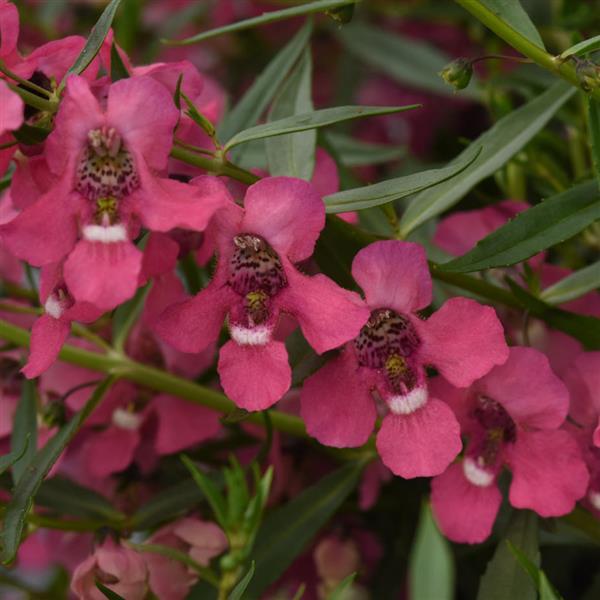Angelonia, AngelMist Spreading Pink
Price range: $7.99 through $9.99
Plant
Discount per quantity
| Quantity | 3 - 8 | 9 - 14 | 15+ |
|---|---|---|---|
| Price | Price range: $7.75 through $9.69 | Price range: $7.51 through $9.39 | Price range: $7.19 through $8.99 |
| % Discount | 3% | 6% | 10% |
Description
AngelMist Spreading Pink Angelonia: A Carpet of Cheerful Blooms
Welcome to the World of AngelMist
Picture a sunny summer day. You walk into the garden, and a gentle wave of soft pink flowers greets you at your feet. That is AngelMist Spreading Pink Angelonia. This variety turns hot, thirsty spaces into pools of pastel color. The blooms look like tiny snapdragons, yet the plant asks for very little in return. It keeps flowering even when the heat feels endless to us. In other words, it is a friend you can count on from late spring until the first cool nights of fall. Let us discover how this little marvel works and how you can make it thrive at home.
Getting to Know AngelMist Spreading Pink
Meet the Plant
Angelonia comes from warm parts of Central and South America. Many gardeners call it “summer snapdragon” because its flowers stand on upright spikes, much like true snapdragons. AngelMist Spreading Pink is part of the AngelMist family, bred to spread outward rather than reach for the sky. The plant stays low, about six to ten inches tall, but it can fan out over eighteen to twenty inches. This habit forms a dense mat that drapes softly over the edge of containers, raised beds, and hanging baskets.
A Symphony in Soft Pink
Each flower spike carries rows of pink blossoms with faint markings in deeper rose. When the plant is in peak bloom, the foliage almost disappears under the sea of color. The flowers arrive in waves, starting in late May or early June and continuing until frost. They give pollinators steady food through the hottest months when other blooms may slow down. Bees love the open throats, and butterflies visit often.
Heat-Loving and Tough
AngelMist Spreading Pink does not wilt at the first sign of heat. In fact, it thrives when temperatures climb into the 90s. The foliage stays glossy and neat, even in sticky humidity. That makes it a perfect choice for southern and midwestern gardens where summer can be relentless. It is hardy as a perennial only in USDA Zones 9 to 11. For the rest of us, we treat it as an annual. Still, its long season of bloom gives great value for one year of effort.
Planting for Success
Choosing the Right Spot
Full sun means at least six hours of direct light each day. AngelMist wants even more if possible. In less than full sun, the plant will stretch and give fewer flowers. Look for a place that stays bright from mid-morning to late afternoon. A south-facing border, a sunny patio pot, or the top level of a tiered planter all work well.
Preparing the Soil
Good drainage is the key. AngelMist dislikes soggy roots. Sandy loam is ideal, but any garden soil improves with organic matter. Work in two to three inches of compost before planting. In containers, use a high-quality potting mix with perlite for extra air pockets. The pH can range between 6.0 and 7.5, so no need for special amendments in most regions.
Spacing and Layout
Because this variety spreads, give each plant space to show off. Set transplants twelve to fourteen inches apart in beds. In a twelve-inch hanging basket, one plant can fill the whole rim. For a patio container fourteen inches wide, two plants create a lush overflow. Remember the final width: about twenty inches. When you leave room, air flows freely and keeps leaves dry, lowering disease risk.
Everyday Care: Simple Steps
Water
When newly planted, water deeply to settle roots. After more than two weeks, let the top inch of soil dry before you water again. In garden beds, one inch of water per week—either from rain or hose—usually is enough. In pots, check daily in hot weather. Lift the container; if it feels light, it is time to water. Deliver the water at the base so foliage stays dry.
Feeding
AngelMist produces hundreds of flowers, so it benefits from steady food. Mix in a slow-release balanced fertilizer at planting time. Then, every two weeks, give a half-strength liquid bloom booster. In containers, nutrients leach out faster, so stay on schedule. If leaves turn pale or bloom slows, that is a signal to feed.
Pruning and Grooming
Unlike many annuals, Angelonia does not need deadheading to keep blooming. Still, you can trim spent flower spikes with clean scissors to prompt quicker new growth. If the plant becomes too wide, cut back the edges by one-third. It will branch out again within a week or two. Always sterilize tools between cuts to stop disease spread.
Temperature and Humidity
AngelMist laughs at heat but not at frost. Plant only after nighttime lows stay above 50 °F. If an unexpected cold snap threatens, cover plants with a light sheet. High humidity does not faze AngelMist, yet good air flow keeps foliage looking its best.
Winter Care
In warm zones 9–11, cut plants back by half in late fall and mulch lightly. They often regrow in spring. Elsewhere, you can take cuttings six weeks before first frost as insurance. Place cuttings in water or moist vermiculite indoors; they root easily and can become next year’s starter plants.
Design Ideas and Companions
Hanging Baskets
AngelMist Spreading Pink cascades over basket edges like a pink waterfall. Combine it with silver licorice plant for soft contrast, or tuck in chartreuse sweet potato vine for a vivid pop. Place the basket at eye level so you and your guests can enjoy the blooms close up.
Ground-Cover Edges
Line a walkway with staggered drifts of AngelMist. The low habit keeps the path tidy while the color guides visitors forward. Pair it with taller salvias in the backdrop. The vertical spikes echo each other, making a rhythm of highs and lows.
Color-Themed Containers
For an elegant pastel scheme, team AngelMist Spreading Pink with lavender verbena and white bacopa. The tiny flowers weave together into one gentle cloud. For a bold mix, set it against deep purple fountain grass. The grass plumes rise above, giving height and drama.
Pollinator Pockets
If you maintain a pollinator garden, AngelMist fits perfectly along the front edge. It keeps feeding insects long after spring bloomers fade. Plant near zinnias, milkweed, and black-eyed Susans for a season-spanning buffet.
Propagating New Plants
Stem Cuttings
- Choose non-flowering shoots about three inches long.
- Clip below a leaf node.
- Strip off the lower leaves.
- Dip the cut end in rooting powder.
- Insert into moist seed-starting mix.
Keep the tray in bright, indirect light. Cover with a clear dome to hold humidity. Roots appear in ten to fourteen days. Once you see new top growth, move each baby plant to its own small pot. Harden them off outdoors for one week before planting in the garden.
Seed Starting
Commercial seed is often pelleted for easy sowing. Start seeds indoors ten to twelve weeks before your last frost date. Press seeds onto the surface; they need light to germinate. Mist gently. Maintain 70 °F soil temperature and even moisture. Seedlings emerge in five to seven days. When they have two true leaves, thin to one per cell. Transplant outdoors when nights are warm.
Troubleshooting Common Issues
Yellow Leaves
Too much water or poor drainage is the usual cause. Check soil moisture. Let the surface dry and reduce watering frequency. Ensure containers have drainage holes.
Few Flowers
AngelMist in shade produces more leaves than blooms. Move the pot or transplant clumps to a sunnier site. Feeding with a balanced fertilizer also helps if soil nutrients are low.
Browning Tips
Salt buildup from fertilizers can scorch leaf edges, especially in pots. Once a month, water containers thoroughly until water drains from the bottom. This leaches excess salts.
Aphids or Whiteflies
These small insects sometimes cluster on young shoots. Blast them off with a strong stream of water. For persistent cases, spray with insecticidal soap, covering leaf undersides. Repeat every five days until clear.
Root Rot
If stems darken at the base and plants collapse, roots may be rotting. Remove affected plants. Improve drainage before replanting. In containers, discard soggy soil and start fresh.
How to Care for AngelMist Spreading Pink All Season
Early Spring
- Start seeds indoors or buy healthy transplants.
- Prepare beds with compost.
- Harden off seedlings by placing them outdoors for one extra hour each day.
Late Spring
- Plant after soil warms and nights stay above 50 °F.
- Water deeply to settle soil.
- Mulch lightly to keep roots cool.
Summer
- Water when the top inch of soil is dry.
- Feed every two weeks with half-strength liquid fertilizer.
- Trim spent flower spikes for fuller blooms.
Early Fall
- Reduce feeding as temperatures drop.
- Take cuttings if you want to overwinter indoors.
- Enjoy the final flush of flowers until the first frost.
Winter (Warm Climates)
- Cut plants back by half.
- Mulch to protect crowns.
- Watch for new shoots in early spring.
Let’s Celebrate the Pink Wave Together
AngelMist Spreading Pink Angelonia invites us to think big even in the hottest months. We place it where other blooms surrender to heat, and it rewards us with steady color. We plant it once, and it fills the season with joy. Its needs are simple: sun, drainage, light feeding, and a little water. Yet the payoff is grand.
Whether you fill window boxes, edge sunny borders, or hang baskets by the porch, this variety brings harmony. It links us, the pollinators, and the summer sky in one living picture. So let us roll out that soft pink carpet and walk into a season of easy beauty, together.
Petals, Sunshine, and Smiles Ahead
Additional information
| Weight | N/A |
|---|---|
| Options | Starter Plug – 3 count, 4 in. (16.9 fl. oz.) Pot |





